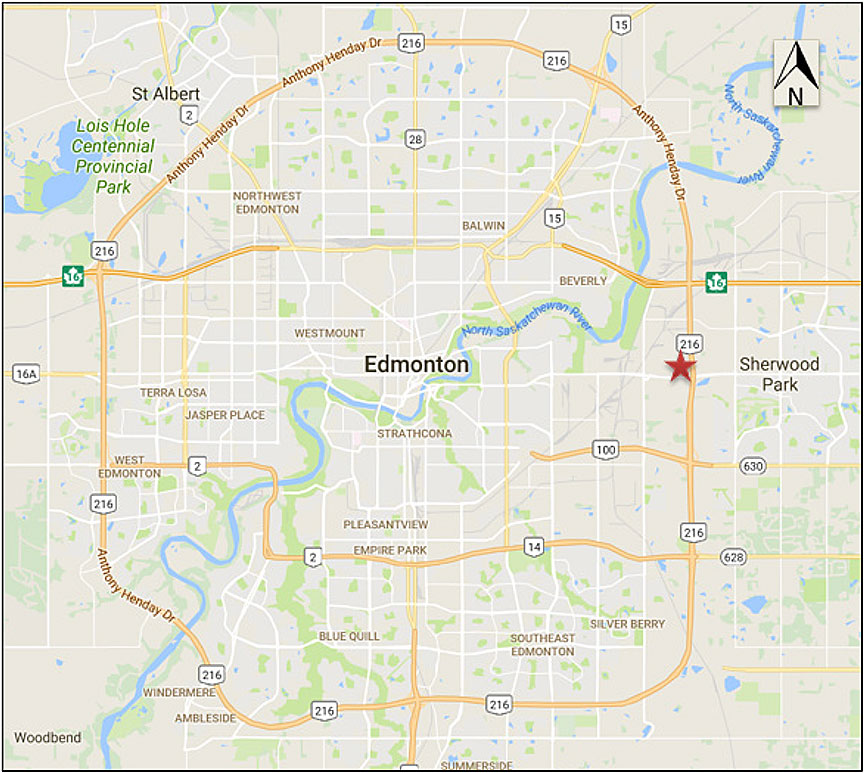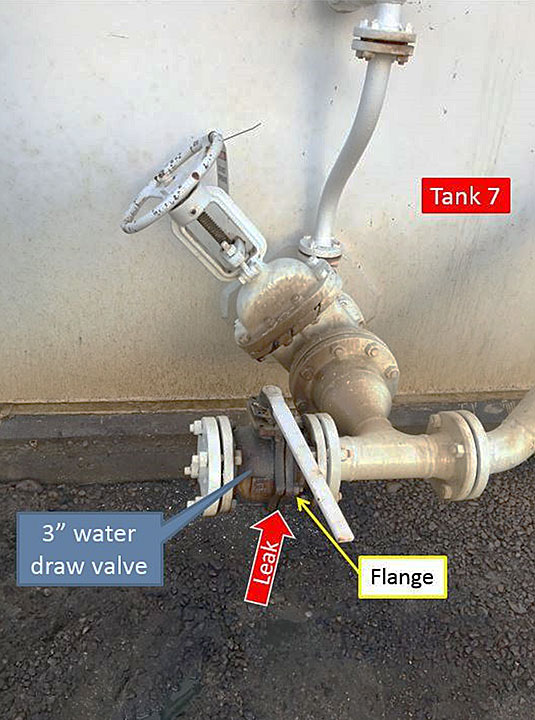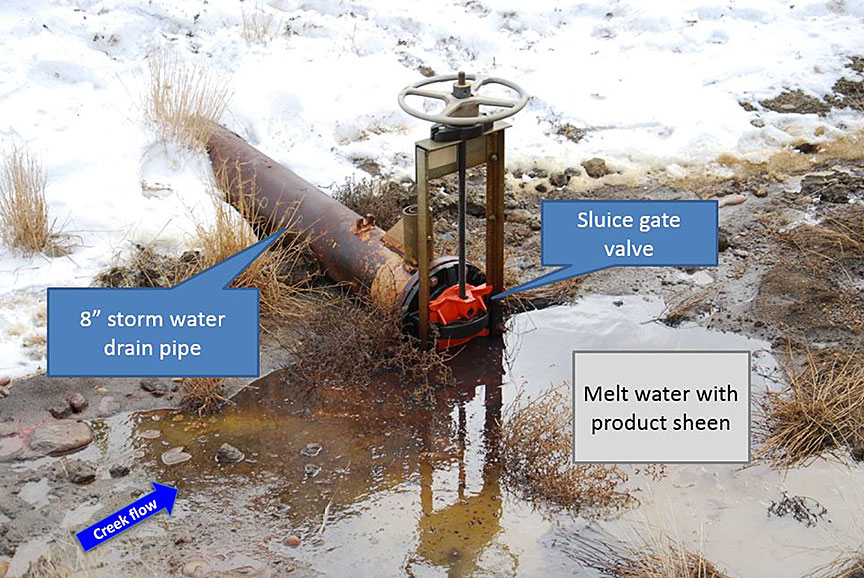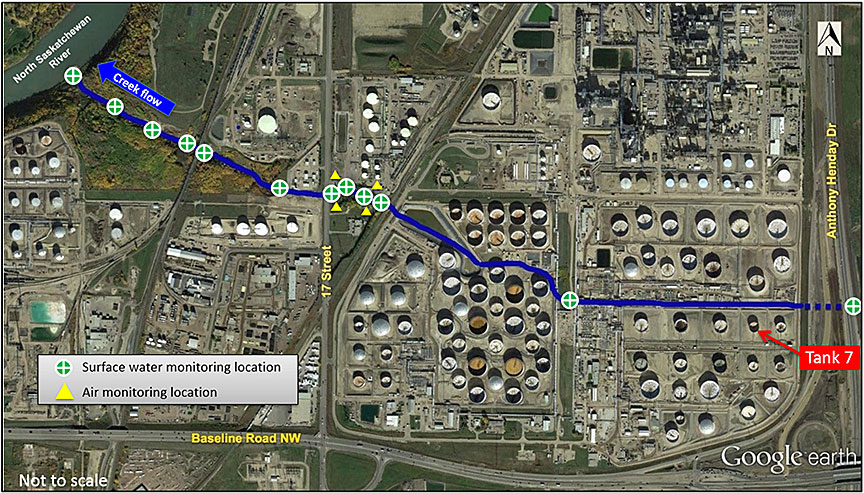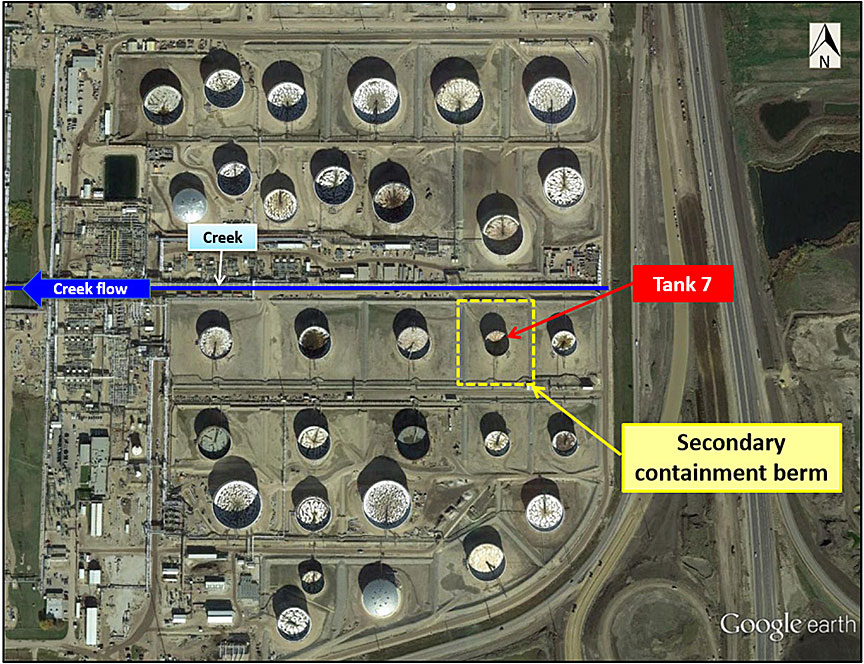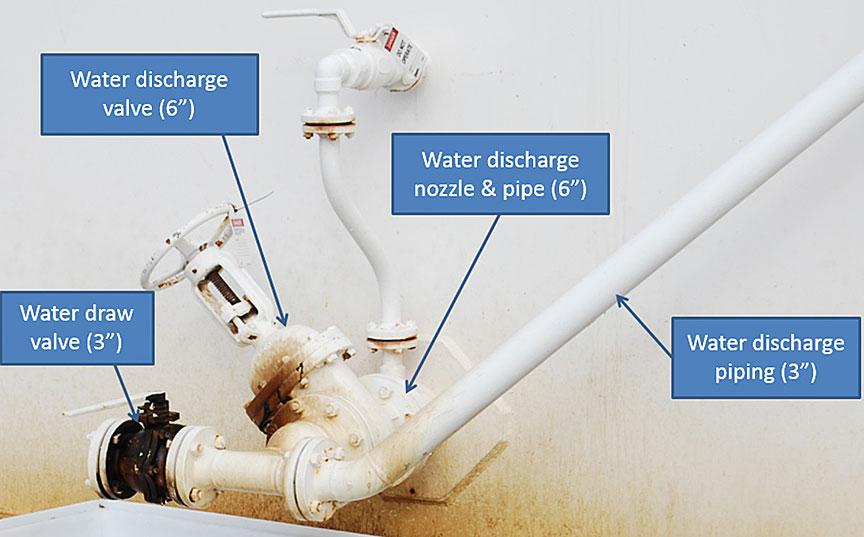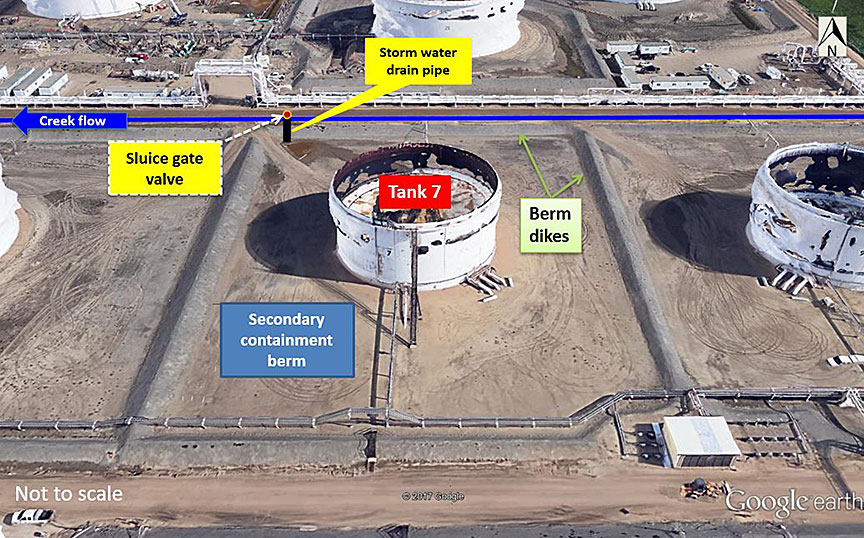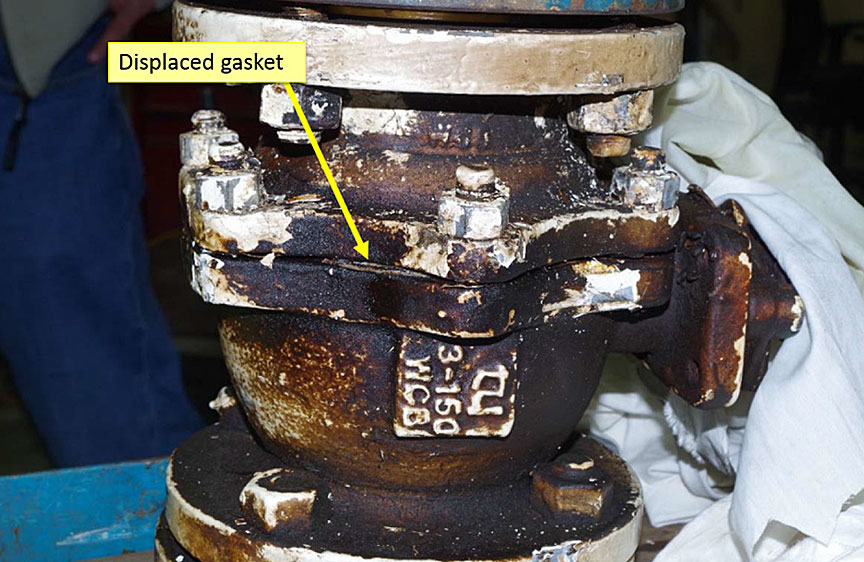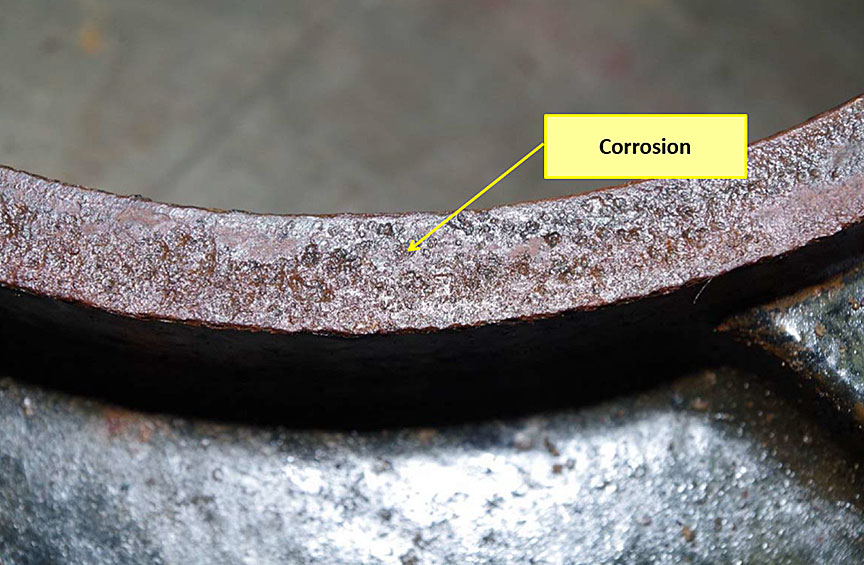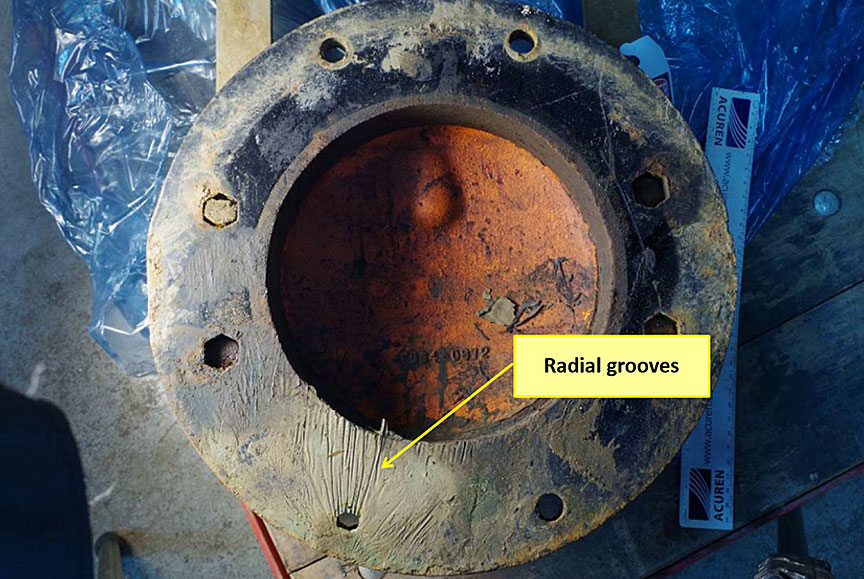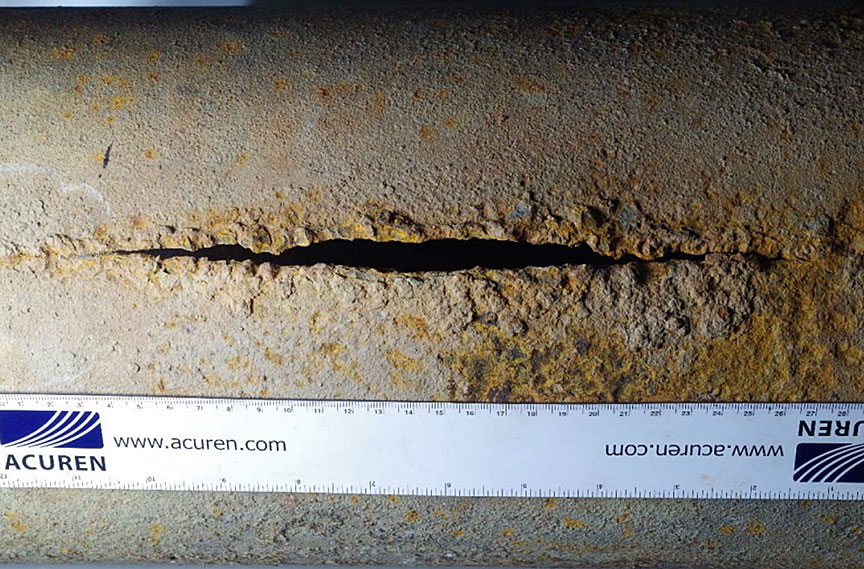Crude oil leak
Enbridge Pipelines Inc.
Edmonton North Terminal
Sherwood Park, Alberta
The Transportation Safety Board of Canada (TSB) investigated this occurrence for the purpose of advancing transportation safety. It is not the function of the Board to assign fault or determine civil or criminal liability. This report is not created for use in the context of legal, disciplinary or other proceedings. See Ownership and use of content. Masculine pronouns and position titles may be used to signify all genders to comply with the Canadian Transportation Accident Investigation and Safety Board Act (S.C. 1989, c. 3).
Summary
On 20 March 2017, at approximately 1445 Mountain Daylight Time, Enbridge Pipelines Inc. discovered traces of crude oil on the water surface in an unnamed creek that runs through the company's Edmonton North Terminal. The source of the product leak was identified to be a 3-inch ball valve from nearby Tank 7. An estimated 10 cubic metres of product was released into the tank's secondary containment berm, of which approximately 3 cubic metres was released from the berm into the creek by way of the berm storm water drainage system. The released product did not reach the North Saskatchewan River. The entire product was recovered. There were no injuries and no evacuation was required.
1.0 Factual information
1.1 The occurrence
On 20 March 2017, at approximately 1445,Footnote 1 during a routine verification, Enbridge Pipelines Inc. (Enbridge) field personnel discovered an oily sheen on the water surface in an unnamed creek that runs through the company's Edmonton North Terminal. That terminal is located within a petrochemical industrial area in Sherwood Park, east of the city of Edmonton, Alberta (Figure 1).
Enbridge personnel immediately reported the discovery by telephone to Enbridge's on-site pipeline maintenance coordinator. At 1448, the maintenance coordinator reported the situation by telephone to the Enbridge Control Centre.
As part of the initial response actions, the Enbridge Control Centre identified facilities in the area that could be the potential source of product leak. At 1452, the preventive shutdown of a pipeline and a receiving manifold located in the vicinity was initiated. No alarms were reported at the Enbridge Control Centre.
At approximately 1500, the maintenance coordinator attended the site and observed product flowing from the outlet of a storm water drain pipe. This pipe discharges storm water accumulated in the secondary spill containment berm of Tank 7, one of the Edmonton North Terminal's crude oil storage tanks. After attempting to manipulate the valve of the drain by tightening the valve's wheel,Footnote 2 the maintenance coordinator confirmed that the valve was shut. However, liquid continued to flow.
At approximately 1510, the maintenance coordinator and other Enbridge personnel conducted a visual survey of the area. A stream of product was observed to be escaping from the valve body gasket on Tank 7. At approximately 1513, the maintenance coordinator reported the situation to the Enbridge Control Centre. At 1516, the Enbridge Control Centre initiated the diversion of product that was being injected into Tank 7.
Between 1520 and 1525, Enbridge personnel tightened the valve body bolts of the leaking valve, significantly reducing the leak. At approximately 1530, Enbridge field personnel manually shut down another valve upstream, which stopped the leak. At 1531, the Enbridge Control Centre initiated the shutdown of Tank 7. The tank was shut down and isolated at 1539.
At 1542, Enbridge informed the operator of the adjacent facility downstream that there had been a leak. The operator immediately initiated the diversion of the creek's incoming surface water stream into its secondary containment system.
At approximately 1545, Enbridge's emergency response plan was activated and the incident command system was initiated. Between 1800 and 1905, Enbridge initiated various regulatory notifications, including local, provincial and federal entities, as well as other companies potentially affected by the occurrence.
There were no injuries, and no evacuation was required. At the time of the occurrence, the sky was clear and the temperature was −3 °C.
1.2 Edmonton North Terminal
The Enbridge Edmonton North Terminal is located within a petrochemical industrial area in Sherwood Park, east of the city of Edmonton. The terminal, which is operated 24 hours a day, includes 31 aboveground storage tanks, manifolds, piping, pumping stations, and valves. Various administrative buildings and emergency response equipment are also located at the terminal (Figure 2).
Each aboveground storage tank in the Edmonton North Terminal is located within a secondary containment berm, which forms a barrier designed to contain any leak or spill from the storage tank.
A creek, approximately 2.6 km long, flows from east to west through the Edmonton North Terminal and into the North Saskatchewan River.
Within the Edmonton North Terminal, over about 750 m, there are a number of culverts along the creek. After exiting the terminal, the creek flows through facilities owned by other companies before discharging into the North Saskatchewan River.
Most of the creek's natural flow consists of storm water and run-off arriving from the east end of the Edmonton North Terminal. In addition, surface and storm water from the facilities located along the creek (including the Edmonton North Terminal's tank berms) is discharged into the creek at specific locations.
1.3 Site examination
During the site examination, these observations were made:
- A stream of product, approximately 6 mm in diameter, was observed to be escaping from the body flange of a 3-inch ball valve (water draw valve)Footnote 3 located at the bottom of Tank 7 (Figure 3).
- Approximately 10 cubic metres (m³) of product had leaked from the valve flange into the tank's secondary containment berm.
- Approximately 3 m³ of the product contained by the berm had discharged into a creek by way of the berm's storm water drainage system, which consists of an 8-inch storm water drain pipe equipped with an 8-inch sluice gate valve (Figure 4).
- Product was observed to be flowing from the bottom of the sluice gate valve area.
- The storm water drain pipe was installed with its longitudinal seam weld located at the 6 o'clock position.
- It was not possible to determine conclusively the exact source of the leak, and there was no evidence of any product release from the drain pipe.
- A small volume of the product released into the creek was carried by the surface waters and had travelled downstream into an adjacent facility.
- Some product exited the adjacent facility and re-entered the creek, but did not travel beyond 17th Street (Figure 2).
- No product reached the North Saskatchewan River.
The tank's 3-inch water draw ball valve and a 1.85 m sectionFootnote 4s of the downstream end of the 8‑inch drain pipe containing the sluice gate valve were sent to the Acuren Group Inc. (Acuren) laboratory in Edmonton for detailed examination.
1.4 Emergency response and recovery of product
Enbridge's Western Region emergency response plan (ERP) was activated and the incident command system was initiated at approximately 1545 on 20 March 2017.
Initial response activities were focused on preventing the released product from travelling further downstream. In addition, clean-up activities were focused on recovering the product, diverting the surface water, and mitigating impacts to the creek.
An air and water monitoring program was put in place shortly after the response operations began in order to monitor for potential contaminants.Footnote 5 The monitoring program included surface water quality sampling and analysis at 12 locations along the creek and air monitoring at 4 locations around the creek (Figure 5).
A total of 48 people (36 Enbridge staff and 12 contractor personnel) were involved in incident command, active response operations, and environmental monitoring.
Response operations included the initial deployment of the spill response equipment located within the Edmonton North Terminal.Footnote 6 This was later supplemented with resources supplied by third-party contractors, including personnel and specialized equipment (e.g., hydrovac trucks).
Incoming water in the creek was temporarily diverted using pumps at the inlet of the creek east of the Enbridge facility to decrease flow in the creek. An increased flow would have adversely affected the response and remediation operations.
Most of the product released into the creek was recovered primarily using absorbent booms, pumps, and hydrovac trucks. Natural flushing and continuous boom collection removed the remainder of the sheen. By 05 April 2017, surface water monitoring results indicated that hydrocarbons or other related contaminants were no longer present in the creek. Continuous surface water monitoring was discontinued on 07 April 2017.
The product that was contained within the Tank 7 berm was recovered by pumping, and then the contaminated granular soil covering the berm's surface was removed and replaced. The remediation of Tank 7's berm surface was completed by 11 April 2017.
The culverted sections of the surface water drainage system that runs through the Enbridge facility and the facility of the other operator downstream were cleaned using steaming techniques. The cleaning of the downstream operator's drainage system was completed by 15 April 2017, and the cleaning of the Enbridge facility was completed by 17 May 2017.
1.5 Tank 7 information
Tank 7 (the tank) is one of the crude oil storage tanks of the Enbridge's Edmonton North Terminal. It is located within a secondary containment berm adjacent to the south of the creek (Figure 6). The tank has a diameter of 33.5 m and is 14.6 m high, with a nominal capacity of approximately 12 700 m³.
The tank was designed according to American Petroleum Institute (API) Standard 12CFootnote 7 and was constructed in 1954 by Horton Steel Works. The tank, manufactured of welded steel plates on a raised concrete ring wall foundation, is equipped with an external steel floating roof.
1.5.1 Piping system for Tank 7
Tank 7 is equipped with various piping and other appurtenances used for tank operation, instrumentation, and maintenance and fire protection systems. The tank is filled by way of a NPSFootnote 8 42 pipe and discharged by way of a set of 3 NPS 24 pipes connected to a manifold.
Various manual and remotely operated valves controlled by the Enbridge Control Centre guide the product flow into and out of the tank, depending on operational requirements.
The tank leak detection threshold is approximately 100 m³.
1.5.2 Water draw system for Tank 7
Tank 7 is equipped with a water draw system. This system consists of a series of smaller-diameter pipes and associated valves designed to periodically withdraw water that may have separated and settled at the bottom of the tank.Footnote 9 Based on operational requirements, water can be withdrawn manually or be set to withdraw automatically during the pumping of product from the tank, depending on the valve configuration. The main components of the water draw system consist of the following (Figure 7):
- a water discharge pipe: a 6-inch pipe attached to the tank by way of a 6-inch nozzle and piping that extends into the tank's sump;
- a water discharge valve: a manually operated 6-inch gate valve that controls the flow of product coming from the water discharge pipe;
- a water draw valve: a manually operated 3-inch ball valve mainly used to manually empty water from the tank; and
- water discharge piping: a section of 3-inch pipe used during automatic water discharge operations.
The 3-inch water draw ball valve was installed in 1995.
At the time that the oily sheen in the creek was discovered, Tank 7 was in operation (i.e., product was flowing in and out of the tank), the 4 valves of the water draw system were in their normal positions, there was 9172 m³ of product (synthetic crude oil) in the tank, and the pressure at the 3-inch water draw ball valve was approximately 83 kilopascals (12 psi).
1.5.3 Secondary containment system for aboveground tanks
Aboveground hydrocarbon storage tanks (such as Tank 7) must have spill control measures to prevent an accidental product release from endangering people, property or the environment.Footnote 10 For example:
- Use a secondary containment tank (this is applicable for smaller storage tanks, less than approximately 45 m³).
- Divert the spilled product away from the storage tanks to a remote impounding area.
- Impound the spilled product by diking around the storage tanks using a liquid-tight design (e.g., materials such as impervious soil, concrete and steel).
Tank 7's secondary containment system consists of a diked containment berm constructed of impermeable compacted clay with a granular (sand and gravel) cover. The diked containment berm is approximately 1.4 m high. The area of the tank lot is approximately 9700 m2, and the volume capacity of the secondary containment is approximately 13 300 m³.
1.5.4 Berm drainage system for Tank 7
The berm's water drainage system (i.e., the drain pipe and the sluice gate valve) is an integral part of the secondary containment system. As per regulatory requirements, the drainage system must be suitable for the expected working conditions and be maintained liquid tight.Footnote 11
Surface and storm water collected within Tank 7's berm is manually discharged as required into the creek by way of a storm water drain pipe located at the northwest corner of the tank lot (Figure 8). The drain pipe is approximately 15 m long and 8 inches in diameter. It slopes approximately 4 degrees downward northward toward the creek. The drain pipe is equipped with a single sluice gate valve mounted on a flange and located at the pipe's outlet. This permits the berm's storm water drainage control to be accessible from outside the containment area, in compliance with regulatory requirements.Footnote 12 The drain pipe had likely been installed at the time of the berm's original construction.Footnote 13 The sluice gate valve was installed in 2012.
The berms and their drainage systems within the Edmonton North Terminal were not equipped with hydrocarbon detection systems and were not required to be.Footnote 14
1.5.5 Procedures for berm storm water management
Enbridge procedures relating to storm water management require the discharge of accumulated storm water in berms after significant rainfalls, or as often as necessary and practicable. The procedures include the following:
- The discharge is conducted in a controlled manner using a slow flow rate to prevent soil erosion and damage to the streambanks and streambed of the waterbody into which the storm water is being released.
- Before discharging accumulated storm water from a containment berm, Enbridge personnel perform a pre-release visual inspection of the berm to identify any oily sheen, suspended solids, or foam that may indicate the presence of product.
- If the visual inspection indicates no evidence of hydrocarbon or other contaminants in the accumulated storm water within the berm, discharge valves are manually opened to discharge storm water off site.
- If the visual inspection indicates that product may be present, storm water is not discharged, and a thorough inspection of the tank and piping within the berm is performed to identify and address the source of any product. Representative samples of the storm water are collected and analyzed for contaminants,Footnote 15 and appropriate mitigation measuresFootnote 16 are implemented. Storm water is released only when subsequent sampling and testing results meet the applicable guidelines.Footnote 17
- After the discharge of storm water is completed, the discharge valve is closed and a "Storm water release form" is completed. The form documents the date, time, pre-release visual inspection results, and estimated volume of discharged storm water from each berm.
During storm water discharge operations, the operating condition or the performance of the berm's drainage system is not specifically inspected. Enbridge procedures pertaining to storm water discharge operations do not require such an inspection.
1.5.6 Previous storm water discharge from Tank 7
The most recent storm water discharge from the Tank 7 berm occurred on 24 August 2016. Approximately 50 000 litres of storm water were discharged. At that time, there was no evidence of the presence of hydrocarbons or any other contaminants within the berm. Therefore, no sampling of storm water was required nor performed.
1.6 Laboratory examination of failed components
The tank's 3-inch water draw ball valve, the 8-inch sluice gate valve and the 1.85 m section of the downstream end of the drain pipe were examined at the Acuren laboratory in Edmonton.
1.6.1 Water draw ball valve
For the 3-inch water draw ball valve, the following observations were made:
- A leak was present at the joint between the 2 valve body halves.
- A portion of the gasket between the body sections was displaced from its original position (Figure 9).
- The gap responsible for the leak was likely due to volume expansion of water contained within the valve cavity upon freezing.
- There was no indication of any flaw in the valve components or of incorrect valve assembly.
1.6.2 Sluice gate valve
For the 8-inch sluice gate valve, the following observations were made:
- The valve leaked slowly at low pressures when tested in the "as received" condition.
- Corrosion had occurred at the valve seat to the extent that it was not possible to achieve a liquid tight seal (Figure 10).
- Mud and dirt, which could have acted as a partial sealant, were present within the valve.
- The valve leaked at higher volumes after being disassembled and cleaned.
- The flange face of the valve, where it attaches to the drain pipe, was covered with a relatively smooth coating of mud. Radial grooves present in the mud coating indicate that water had likely flowed through this area (Figure 11).
1.6.3 Drain pipe section
For the 1.85 m section of the 8-inch drain pipe, the following observations were made:
- The pipe was uncoated.
- The pipe had been manufactured using a manual longitudinal seam weld.
- The weld, which was of poor quality, had likely been made using an oxyacetylene welding process.
- There were 4 holes through the weld, the largest of which had a diameter of approximately 3 mm. The holes had been formed at the time the pipe was manufactured.
- A 258 mm–long split at the longitudinal seam weld was present. The split, which had likely occurred a number of years ago, had a maximum width of 12 mm (Figure 12).
- The split was likely due to water freezing within the pipe.
- The pipe had suffered considerable wall loss due to oxygen corrosion in the presence of water. The corrosion likely occurred over a very long period of time.
1.7 Regulatory requirements for integrity management program
Section 40 of the National Energy Board Onshore Pipeline Regulations (OPR) requires a company to develop, implement and maintain an integrity management program (IMP). The OPR further require pipeline operators, through incorporation by reference, to adhere to applicable mandatory provisions of the latest edition of Canadian Standards Association (CSA) Standard CAN/CSA-Z662-15.Footnote 18
While the Guidance Notes for the OPR provide direction in developing an IMP, regulated companies have flexibility and discretion to develop the content of their respective plans. Therefore, regulated companies develop IMPs tailored to their specific operations, and initiate corrective action as required, in compliance with applicable provisions and criteria set in CAN/CSA-Z662-15.
The National Energy Board (NEB) expects regulated companies, as part of their IMP, to have procedures that provide clear guidance or specific instructions on how to manage the integrity of their storage tanks and secondary containment in general, and to ensure that their components such as those involved in this occurrence are properly inspected and maintained.
The NEB also expects companies, as part of their IMP, to proactively identify and continually monitor the specific hazards associated with their pipelines and associated facilities, and to immediately update their IMP when new hazards are identified.
The effectiveness of each regulated company's program is monitored by the NEB on an ongoing basis (generally annually) with the goal of ensuring that pipelines and associated facilities are suitable for continued safe, reliable, and environmentally responsible service.
1.8 Requirements for the inspection of aboveground storage tanks
Relevant clauses of CAN/CSA-Z662-15 pertaining to the inspection and testing requirements of aboveground storage tanks (such as Tank 7) and their secondary containment berms include the following:
-
CAN/CSA-Z662-15, clause 10.9.2.1
[…] the inspection, repair, alteration, and reconstruction of aboveground atmospheric steel tanks shall be as specified in API 653.Footnote 19
- CAN/CSA-Z662-15, clause 10.9.2.5
Secondary containment for aboveground tanks shall be inspected periodically and maintained as necessary to be in accordance with the design requirements.
Other related requirements include the following:
- API Standard 653, which is incorporated by reference in CAN/CSA-Z662-15, provides minimum requirements for maintaining the integrity of steel tanks built to API Standard 650 (and to its predecessor, API Standard 12C) after the tanks have been placed in service. It addresses tank inspection, repair, alteration, relocation, and reconstruction.
- API Standard 653 contains provisionsFootnote 20 addressing periodic inspection of tanks for ensuring continued tank integrity. It has a list of elements for consideration, such as tank components that need to be inspected, inspection type, frequency, methods and techniques as well as inspector qualifications. In addition, API Standard 653 contains checklistsFootnote 21 to help guide operators when developing inspection assessment schedules tailored to their specific tank installations as well as to facilitate the recording of inspection findings.Footnote 22
1.9 Enbridge's integrity management program
Enbridge's Safety Management System Framework (SMS framework) is the overarching common standard across all of Enbridge's business lines for activities pertaining to process safety, personal safety, and operational reliability. Enbridge's IMP is aligned with its SMS framework.
Within Enbridge's IMP, there are processes to identify hazards, assess risks, and develop and implement control measures to mitigate those risks. These control measures, which include procedures, standards, and tools, are further referenced in Enbridge's Operations and Maintenance Manual (OMM).
1.10 Enbridge's inspection procedures for aboveground storage tanks
Enbridge staff perform a visual inspection of each storage tank and berm twice daily, at the start of every shift, as part of pre-shift verifications. These daily inspections include tank valves, flanges, and piping, as well as berm drainage systems for any damage, leak or presence of product (i.e., oily sheen, suspended solids, or foam). Any identified defect is assessed for remediation (including repair or replacement, as appropriate). On the day of the occurrence, no abnormal operating conditions were noted during the scheduled pre-shift inspection of Tank 7 and its berm.
In addition to the daily inspections, Enbridge's inspection and maintenance program for aboveground storage tanks is contained in Book 6 (Equipment Maintenance) of the company's OMM.Footnote 23
The inspection and maintenance program is based on standards required by the OPR, such as CAN/CSA-Z662-15. These standards are supplemented by Enbridge-developed practices as well as other industry standards and recommended practices, such as relevant provisions in codes and/or standards of the API and the National Fire Protection Association (NFPA).
According to the OMM, all Enbridge storage tanks and berms are subject to monthly inspections, annual inspections, 5-year inspections, and 10- to 30-year out-of-service inspections.
The OMM does not specifically address the inspection of tank or berm components that may be affected by hazards such as freezing due to seasonal temperature variations.
1.10.1 Monthly inspections
Qualified Enbridge personnel perform monthly inspections of aboveground storage tanks in accordance with a checklist of components to be examined. Observations are recorded on the checklist and entered into Enbridge's facilities management system, and the necessary corrective actions are implemented.
With respect to tank appurtenances (including valves and flanges), the inspection provisions require a visual inspection of the tank shells, valves, flanges, piping and other equipment for any leak, damage, and/or abnormal condition. There was no specific provision related to the inspection of secondary containment systems.
The checklist of components is contained in the OMM. However, there are no specific instructions, procedures, or acceptance criteria for the performance of the monthly inspections for the listed components.
1.10.2 Annual inspections
Qualified Enbridge personnel perform annual inspections of aboveground storage tanks in accordance with a list of components to be examined outlined in a form referenced in the OMM (the Annual External Tank Inspection Form).
Annual inspections are performed without taking the tank out of service, and include a visual inspection of identified components of the storage tank and associated equipment and facilities.
With respect to tank appurtenances (including valves and flanges) and secondary containment systems (berms), the inspection provisions require the following:
- the inspection of the condition of the tank appurtenances and a verification for leaks around piping, nozzles, flanges, and bolting; and
- the inspection of the tank lot and berm and a verification of the correct operation of the containment drains.
Inspection results and findings are recorded on the Annual External Tank Inspection Form and entered into Enbridge's facilities management system. Following an assessment of each identified issue, the necessary follow-up actions are determined and implemented.
There are no specific instructions, procedures, or acceptance criteria for the performance of the annual inspections for the components listed in the Annual External Tank Inspection Form.
1.10.3 5-year inspections
API Standard 653–certified inspectors perform the 5-year inspections of aboveground storage tanks in accordance with the applicable provisions of API Standard 653.
According to API Standard 653, 5-year inspections are generally performed without taking the tank out of service, and include a structural inspection of the storage tank and associated equipment and facilities using visual and various non-destructive testing methods.
With respect to the inspection of tank appurtenances (including valves and flanges) and secondary containment systems (berms), API Standard 653 requires the following:Footnote 24
- the inspection of tank manifold piping, flanges and valves for leaks; and
- a verification of the operating conditions of the dike drains.
A detailed report based on API Standard 653 requirements, including the inspection results, findings and remediation recommendations (if any), is prepared by the API Standard 653–certified inspectors.
Inspection results and required follow-up actions are entered into Enbridge's facilities management system, and the necessary remediation measures are developed and implemented as required.
While the OMM refers to API Standard 653 for the performance of the 5-year inspections, it does not contain any additional provisions regarding the selection of the tank components to be inspected or any specific instructions, procedures, or acceptance criteria tailored to the company's specific tank installations.
1.10.4 10- to 30-year inspections
API Standard 653–certified inspectors perform the 10- to 30-year inspections of aboveground storage tanks in accordance with the applicable provisions of API Standard 653.
According to API Standard 653, 10- to 30-year inspections include a detailed evaluation of the integrity of the storage tank and associated facilities, and are performed after the tank has been taken out of service, cleaned and purged, and some appurtenances removed. A detailed structural inspection of the storage tank from both outside and inside the tank is performed using visual and various non-destructive testing methods. Tank appurtenances (such as valves, gauges, and associated piping) are inspected and/or maintained as appropriate while they are removed from the tank.
A comprehensive report based on API Standard 653 requirements detailing the inspection results, findings, and remediation recommendations (if any) is prepared by the API Standard 653–certified inspectors.
Inspection results and all required follow-up actions are entered into Enbridge's facilities management system, and the necessary remediation measures are developed and implemented as required.
While the OMM refers to API Standard 653 for the 10- to 30-year inspections, it does not contain any additional provisions regarding the selection of the tank components to be inspected or any specific instructions, procedures or acceptance criteria tailored to the company's specific tank installations.
1.11 Integrity inspections of Tank 7 and its secondary containment berm
Tank 7 (including its secondary containment berm) was subject to periodic inspections as per the OMM.
The most recent daily inspection of Tank 7 and its berm had been completed on 20 March 2017 at about 0800 by Enbridge staff, at the beginning of their shift. No abnormal operating conditions were noted at that time. The most recent monthly inspection had been performed on 09 March 2017. No leaks, damage, or abnormal conditions were noted on the tank or on any of the valves and other appurtenances.
Since 2010, in addition to the daily verifications and monthly inspections, there had been 4 annual inspections and two 5-year inspections.
Table 1 presents a summary of the most recent annual inspections and 5-year inspections.
| Inspection type | Month and year | General comments |
|---|---|---|
| Annual | August 2016 | No leaks around piping, nozzles, flanges, and bolting were identified. However, it was not possible to assess the correct operation of the dike drains because water was present in the berm as a result of heavy rainfall the previous night. |
| 5-year | July 2015 | No leaks in tank manifold piping, flanges, and valves were identified. The dike drains were operating correctly. |
| Annual | July 2014 | No leaks around piping, nozzles, flanges, and bolting were identified. However, it was not possible to assess the correct operation of the dike drains due to the berm being drained. |
| Annual | June 2013 | No leaks around piping, nozzles, flanges, and bolting were identified. The dike drains were operating correctly. |
| Annual | September 2012 | No leaks around piping, nozzles, flanges, and bolting were identified. The dike drains were operating correctly. |
| Annual | September 2011 | No leaks around piping, nozzles, flanges, and bolting were identified. The dike drains were operating correctly. |
| 5-year | April 2010 | No leaks in the tank manifold piping, flanges and valves were identified. The dike drains were operating correctly. |
The most recent 10- to 30-year inspection of Tank 7 was completed in 2000.
1.12 Regulatory oversight by the National Energy Board
The NEB requires regulated pipeline companies to anticipate, prevent, mitigate, and manage any hazards and risks associated with their operations.
The NEB evaluates regulated companies and their facilities and installations through a risk model to determine appropriate compliance verification activities. This evaluation includes the following:
- an identification of potential consequences to people and the environment posed by facilities or an installation based on the products carried, physical properties of the pipe or facilities, and proximity to receptors such as water bodies, environmentally sensitive areas, land-use, population density and presence of workers; and
- a review of historical information on the company's or operator's management of these consequences collected through previous compliance monitoring activities.
The NEB uses a number of tools to verify compliance of companies under its jurisdiction with the National Energy Board Act, regulations, and any project-specific conditions imposed by the NEB. While audits and inspections are key components of the compliance process, other verification tools include formal compliance meetings, review of environmental and emergency management reports and manuals, and the evaluation of emergency response exercises.
1.12.1 Audits and inspections
NEB audits are a systematic evaluation of an NEB-regulated company's management system, including programs, practices, procedures, plans, processes, manuals, records, and activities. The objective is to verify a company's compliance with the applicable regulatory requirements, which include a fully developed and implemented management system, and appropriate protection programs in the appropriate areas. Such areas may include damage prevention, emergency management, environment, pipeline integrity, safety, and security. After completing an audit, the NEB communicates its findings to the company.
NEB field inspections are an on-site, methodical examination and assessment of a company's regulated activities or operations against specific regulatory requirements. NEB inspections include an assessment of an inspected company's actions pertaining to the specifics of the activities being inspected. In general, NEB inspection officers do not perform physical tests on components.
If non-compliances are found following an audit or an inspection, the NEB directs the company to resolve and/or correct all non-compliances within specific time limits.Footnote 25 Companies may also be required to pay a monetary penalty, operate under restricted conditions, or not be allowed to operate at all.
1.13 Regulatory oversight of Enbridge
1.13.1 Audit of Enbridge's regulated activities
The NEB's most recent audit of Enbridge's regulated activities was initiated in May 2014. This audit covered the following program areas:
- Safety Management Program
- Integrity Management Program
- Emergency Management Program
- Environmental Protection Program
- Third Party Crossings Program
- Public Awareness Program
The final audit report was issued by the NEB in March 2015. The audit report indicated the following:
- The processes used by Enbridge identified the majority, and most significant, of its hazards.
- Enbridge had developed and implemented the operational controls and inspection and monitoring programs to address these hazards.
- The safety-related practices and procedures were well established within Enbridge's organization.
- Non-compliancesFootnote 26 in several areas were found. Several opportunities for improvement in Enbridge's management practices were identified. In particular, a non-compliant finding relating to Enbridge's governance management system process was identified. It was found that, although Enbridge had developed controls that addressed identified hazards and risks, there were deficiencies in Enbridge's design and implementation of the processes used for the development of these controls.
Following the audit, the NEB determined that no enforcement actions were immediately required and directed Enbridge to submit a corrective action plan within 30 days to address all identified non-compliances.
In response to the audit report, Enbridge developed and submitted to the NEB a corrective action plan addressing all the non-compliances identified. The majority of the corrective actions have been approved by the NEB and either have been or are being implemented by Enbridge.Footnote 27
1.13.2 Compliance verification at the Enbridge Edmonton North Terminal
In the 5 years before the occurrence, the NEB had conducted 3 field inspections at the Edmonton North Terminal. The inspections were focused on regulatory compliance in the following areas:
- Occupational health and safety
- Emergency shutdown systems
- Integrity matters pertaining to the construction of new facilities.
No significant issues were identified during these inspections. All identified minor non-compliances had been addressed by Enbridge to the NEB's satisfaction.
2.0 Analysis
No tank or berm design deficiencies or tank operating issues were found as contributing to this occurrence. The analysis will focus on tank and berm inspections and on integrity management.
2.1 The occurrence
The leak occurred when crude oil was released from Tank 7 into its secondary containment berm through a flange joining the 2 halves of a 3-inch ball valve that is part of the tank's water draw system.
The gasket between the 2 body sections of the 3-inch ball valve had been displaced out of its original position. The displacement of the gasket was likely due to volume expansion of water within the valve cavity that had frozen.
Some of the leaked product that was initially retained within the secondary containment berm was released into the creek from the berm's storm water sluice gate valve.
The seat of the sluice gate valve, which was corroded, could not achieve a liquid tight seal. Furthermore, there were indications that the flange between the sluice gate valve and the drain pipe was permeable to water.
Within the berm drain pipe, a 258 mm–long split in the pipe's longitudinal seam had occurred, likely due to freezing of water. Furthermore, the drain pipe was not liquid tight at the time of manufacturing due to the presence of a number of holes in its longitudinal seam weld. It could not be determined if this contributed to the leak.
2.2 Occurrence discovery and response
The occurrence was initially discovered at approximately 1445 on 20 March 2017 by Enbridge Pipelines Inc. (Enbridge) field personnel during a routine verification.
Product had leaked from the tank for up to 7.5 hours. The total released quantity of product, 10 m³, was well below the 100 m³ threshold of the tank's leak detection system, and no alarms were reported.
The berms and their drainage systems at the Edmonton North Terminal were not equipped with hydrocarbon detection instrumentation, nor were they required to be by regulation. The terminal operates 24 hours a day, and Enbridge relies on regular site patrols as well as inspections performed by field personnel twice per day at the start of every shift. These verifications include the inspection of each storage tank, containment berm, and drainage system for any damage or leaks, or for the presence of product.
After the pipeline maintenance coordinator was notified of the occurrence, response was initiated in 4 minutes. The origin of the leak was identified within approximately 25 minutes and the leak was stopped approximately 45 minutes after it was discovered. Enbridge's emergency response plan was activated approximately 1 hour after the discovery of the release.
Emergency response resources, which were available on site, were deployed in a timely manner to successfully mitigate the impacts of the release. The aim of the initial response activities was to prevent any of the released product from travelling further downstream of the creek. Air and water monitoring programs were put in place. All released product was recovered from the containment berm or from the creek before the product reached the nearby North Saskatchewan River.
2.3 Integrity management
Aboveground storage tanks (including their secondary containment berms) need to be inspected and tested periodically in accordance with American Petroleum Institute (API) Standard 653, an industry standard that sets minimum requirements for periodic inspection of tanks to ensure continued tank integrity. API Standard 653 contains general guidance for performing the required inspections, and operators are expected to develop inspection assessments and schedules tailored to their specific tank installations, taking into account the operating conditions and environment.
With respect to secondary containment berms, these systems are further required (by regulations) to be suitable for the expected working conditions, be maintained liquid tight, and be inspected and maintained as necessary in accordance with the design requirements.
In accordance with Enbridge's integrity management program (IMP), the inspection and maintenance activities of aboveground storage tanks are described in the company's Operations and Maintenance Manual (OMM) and consist of 4 types of periodic inspections: monthly, annual, 5-year, and 10- to 30-year. In addition, field personnel visually inspect the terminal at least twice a day.
All the periodic inspections in the OMM are primarily based on checklists and guidance derived from API Standard 653 for identifying the components to be examined and, for each set of components, the general performance characteristics to verify.
During the periodic tank and berm inspections carried out since 2010, tank appurtenances (including valves and flanges) were visually inspected for signs of cracks, corrosion, or leakage. Secondary containment berms were assessed based on a visual observation of the berm and a verification of the operating condition of the drainage system.
The periodic tank and berm inspections did not identify any of the defects or component deficiencies that subsequently failed.
No detailed procedures were in place to assist inspectors with evaluating the condition of tank or berm components and with determining whether the components were suitable for continued service.
2.4 Compliance verification of Enbridge Pipelines Inc.
The National Energy Board (NEB) initiated an audit of Enbridge's regulated activities in May 2014, which included the review of the company's safety, integrity, and environmental management programs.
Although the NEB audit findings included a deficiency in Enbridge's governance management system process, the audit determined that Enbridge had developed and implemented the operational controls and inspection and monitoring programs to address the majority, and most significant, of its hazards, and that the safety-related practices and procedures were well established within Enbridge's organization. Corrective actions associated with findings related to integrity management have been completed by Enbridge and verified by the NEB.
The NEB's oversight of Enbridge was conducted in a manner consistent with established regulatory practices.
3.0 Findings
3.1 Findings as to causes and contributing factors
- The leak occurred when crude oil was released from Tank 7 into its secondary containment berm through a flange joining the 2 halves of a 3-inch ball valve that is part of the tank's water draw system.
- The gasket between the 2 body sections of the 3-inch ball valve had been displaced out of its original position.
- The displacement of the gasket was likely due to volume expansion of water within the valve cavity that had frozen.
- Some of the leaked product that was initially retained within the secondary containment berm was released into the creek from the berm's storm water sluice gate valve.
- The seat of the sluice gate valve, which was corroded, could not achieve a liquid tight seal.
- No detailed procedures were in place to assist inspectors with evaluating the condition of tank or berm components and with determining whether the components were suitable for continued service.
3.2 Other findings
- There were indications that the flange between the sluice gate valve and the drain pipe was permeable to water.
- Within the berm drain pipe, a 258 mm–long split in the pipe's longitudinal seam had occurred, likely due to freezing of water.
- The drain pipe was not liquid tight at the time of manufacturing due to the presence of a number of holes in its longitudinal seam weld. It could not be determined if this contributed to the leak.
- Emergency response resources, which were available on site, were deployed in a timely manner to successfully mitigate the impacts of the release.
- All released product was recovered from the containment berm or from the creek before the product reached the nearby North Saskatchewan River.
- The National Energy Board's oversight of Enbridge Pipelines Inc. was conducted in a manner consistent with established regulatory practices.
4.0 Safety action
4.1 Safety action taken
4.1.1 Enbridge Pipelines Inc.
Following the occurrence, Enbridge Pipelines Inc. (Enbridge) took the following actions:
- An internal investigation was initiated to identify the root cause(s) of the occurrence.
- On 10 April 2017, an alert was issued to complete a more thorough inspection of all water draw components on storage tanks, and to complete and document all follow-up actions.
- Water draw systems were inspected and additional containment (drip trays) was placed under all storage tank water draw piping as an immediate interim measure.
- On 13 July 2017, an alert was issued to inspect all secondary containment berm drainage system components for liquid-tightness, and to complete and document all follow-up actions.
- Work was initiated to ensure all tank water draw systems are put in a freeze/thaw protected state.
- A review of the company's tank and berm inspection and maintenance procedures was initiated.
- A review of the Edmonton Terminal facility hazard assessment was initiated.
- A review of the Edmonton Terminal Water Management Plan was initiated.
- A review of the Edmonton Terminal Emergency Response Plan was initiated.
4.1.2 National Energy Board
Following the occurrence, the National Energy Board (NEB) took the following actions:
- On 21 March 2017, the NEB initiated a review of the occurrence to verify compliance of the Enbridge Edmonton North Terminal with regulatory requirements and to ensure that adequate corrective, preventive and safety actions were identified and implemented.
- The NEB monitored Enbridge's initial clean-up and remedial actions on site.
As part of its ongoing incident review activities, the NEB continues to monitor Enbridge's response to the occurrence and the implementation of the corrective and preventive actions necessary to prevent the recurrence of similar events.
This report concludes the Transportation Safety Board of Canada's investigation into this occurrence. The Board authorized the release of this report on 06 December 2017. It was officially released on 19 December 2017.
